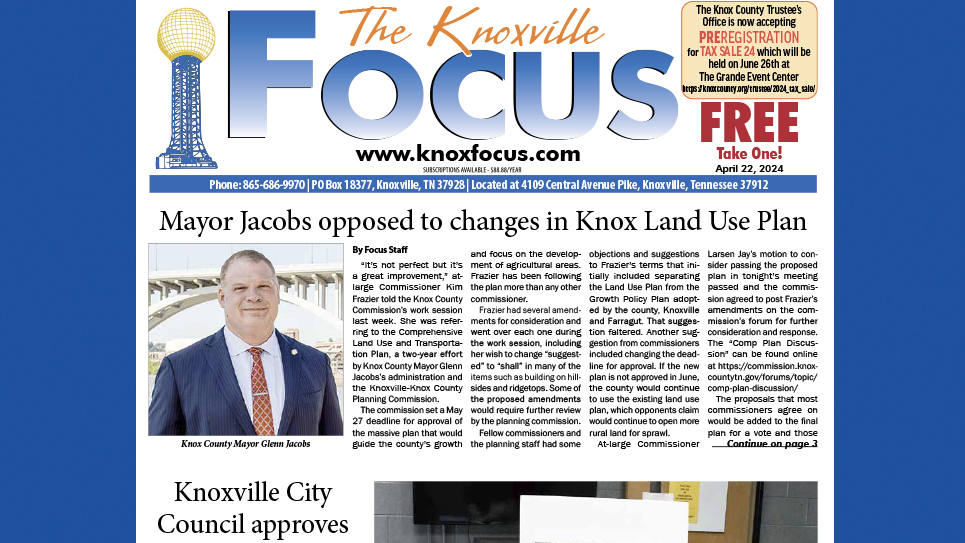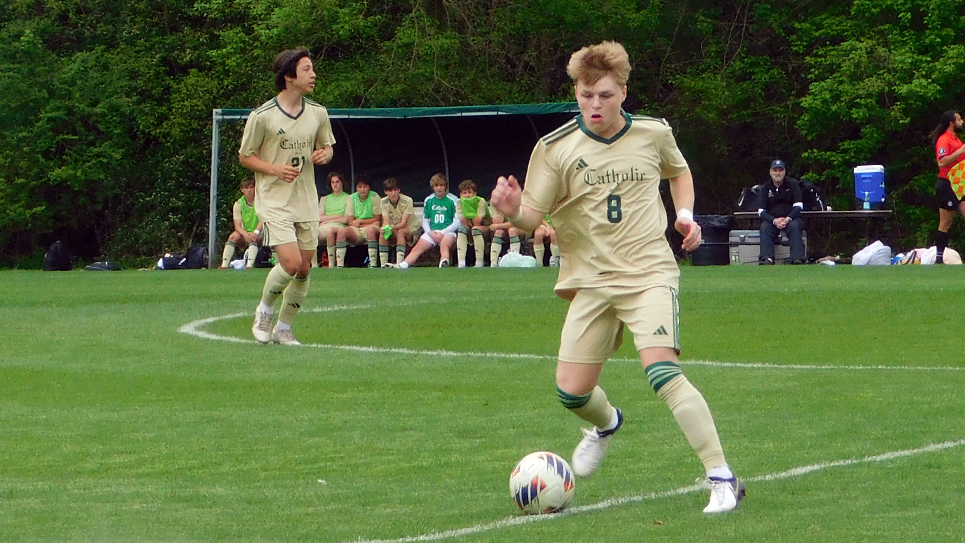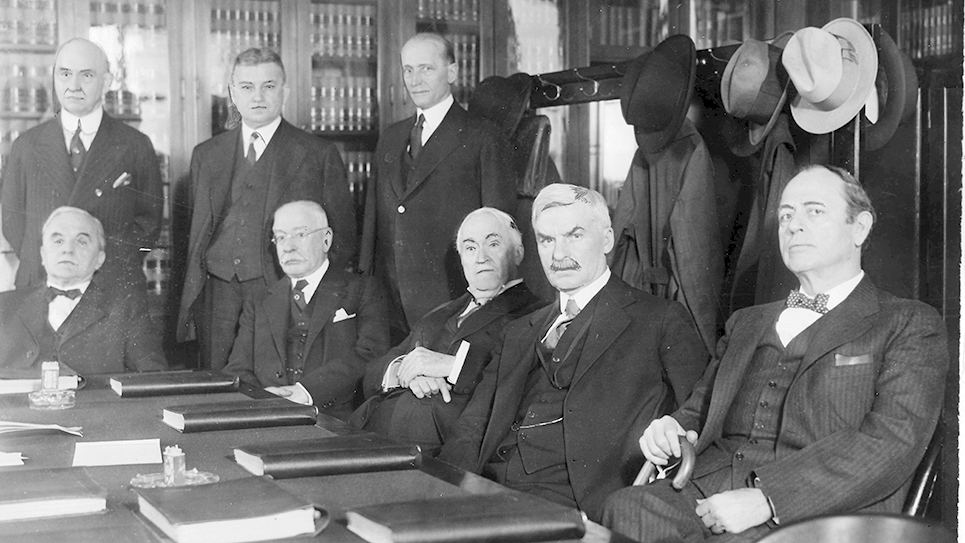
From the author’s personal collection.
Harry Truman’s Vice Presidential portrait unveiled. From left to right, Senator K. D. McKellar, Vice President Harry Truman, Senate Majority Leader Alben Barkley and Secretary of the U. S. Senate Leslie Biffle.
By Ray Hill
Only three men served less time in office as Vice President of the United States than Harry S. Truman. John Tyler succeeded to the presidency after thirty-one days when William Henry Harrison caught cold, which turned into pneumonia. Andrew Johnson had been vice president for forty-two days when Abraham Lincoln was assassinated. William Rufus King had been vice president for forty-five days when he died in office.
Harry Truman had been vice president for eighty-two days when Franklin Delano Roosevelt died at the Little White House in Warm Springs, Georgia.
When 1944 began, few people thought Harry Truman would become vice president, much less President of the United States. Personal relations between Truman and President Roosevelt had never been especially warm, despite the little man from Missouri having supported practically everything FDR wanted from the Congress. Senator Truman simmered while patronage in Missouri flowed into the hands of his senior colleague, Bennett Champ Clark, an isolationist and a fierce opponent of much of the New Deal. Periodically, Truman would let his resentment bubble over and FDR would summon the Missourian to the White House for a brief chat.
Senator Truman once confided to Owen Brewster, a Republican colleague from Maine, the worst thing about Franklin Roosevelt was, “He lies.” Typically succinct for Harry Truman.
The leaders of the party, Robert Hannegan, oilman Edwin Pauley, Chicago Mayor Edward Kelly, and Ed Flynn, boss of the Bronx in New York, met with President Roosevelt to tell him they would oppose incumbent Henry Wallace being renominated. They proposed replacing Wallace with Senator Harry Truman.
Roosevelt replied that he “hardly knew” Truman.
Harry Truman’s rise began as it become more and more obvious to the men who ran the Democratic Party that Franklin D. Roosevelt was seriously ailing. While the party mahatmas may have suspected FDR was ill, very few people knew the truth. President Roosevelt had suffered from hypertension since 1937. As the pressures of World War II weighed upon him, Franklin Roosevelt’s health began to deteriorate. A specialist from Walter Reed Naval Hospital was summoned who determined Roosevelt was cyanotic, very short of breath, with rales in his lungs. Rales are odd noises, comparable to the sound of cellophane being crumpled. When examined by Dr. Howard Bruenn, President Roosevelt was also found to be suffering from congestive heart failure and hypertensive heart disease, as well as a serious case of bronchitis. Dr. Bruenn insisted the president cut back his fondness for cigarettes, get at least ten hours of sleep each night, and prescribed digitalis for FDR’s heart disease. Dr. Bruenn also suggested President Roosevelt’s work schedule be curtailed, hardly a realistic expectation for a chief executive who was busy running a war that was being waged all across the globe.
For party bosses, it was bad enough their champion vote-getter was declining, but even worse was the occupant of the vice president’s office: Henry Agard Wallace of Iowa. Wallace was one of the most unlikely politicians imaginable. Wallace had been a Republican for most of his life and been FDR’s Secretary of Agriculture for eight years before Roosevelt selected him as his running mate in 1940. It was a choice that bordered on the bizarre; Wallace had no electoral base, had never been elected to any office prior to being picked to run for vice president. Wallace brought no strength to the ticket, a point that was underscored when Roosevelt lost Iowa to Republican Wendell Willkie.
Henry Wallace was socially awkward, naïve and completely unsuited for the rough and tumble of politics.
Senator Joseph F. Guffey was the boss of the Democratic Party in Pennsylvania and a 100% New Dealer. When Guffey casually wondered what Harry Truman thought of Vice President Wallace, Truman’s reply summed up what most every important Democrat in the nation thought.
“He’s the best Secretary of Agriculture this country ever had,” Truman laughed.
Many a Democrat’s heart began to beat a little faster as the National Convention approached and just about anyone asking Franklin Roosevelt whom he preferred as his running mate underscored Harry Truman’s comment about FDR’s veracity. Roosevelt apparently encouraged them all.
Earnest to the core of his being, Henry Wallace pointblank asked Roosevelt if the president wanted him off the ticket. FDR assumed a horrified air and assured Wallace that was not the case. Yet he sent Wallace on a mission to Asia that kept the vice president out of the country for months.
Former Indiana governor Paul McNutt wanted to be vice president, as did a host of other Democrats. Senator Alben W, Barkley of Kentucky coveted the nomination and Speaker of the House Sam Rayburn of Texas had more than a passing interest. North Carolina’s governor J. Melville Broughton thought his chances just as good as anyone’s. Alabama Senator John H. Bankhead, II wanted to be vice president too, but perhaps the most formidable threat to Henry Wallace was “Assistant President” James F. Byrnes of South Carolina. Byrnes had been a congressman, senator and Associate Justice of the United States Supreme Court. Byrnes was a very shrewd man and a wonderful biography entitled “Sly and Able” was written by David Robertson. Mr. Robertson managed to sum up Jimmie Byrnes perfectly.
It seemed every Democrat in the country wanted to be vice president except for Harry Truman.
When Senator Joe Guffey asked Truman what he thought about being vice president, Truman reputedly replied with, “Shit!”
The very sly and able Jimmie Byrnes, equally assured by President Roosevelt that he should seek the vice presidential nomination, immediately sought to neutralize any Truman candidacy. Byrnes asked his friend Harry Truman to place his name in nomination and Truman readily agreed.
Byrnes went to the Chicago convention as an open candidate, but his candidacy immediately ran into trouble. Some were already concerned about how many votes Byrnes would cost the ticket in the big northern cities as a Southern Democrat; he had converted from the Catholic Church to become an Episcopalian, something that might cause many Catholics to frown with displeasure. Labor leader Sidney Hillman was adamantly opposed to the idea of Jimmie Byrnes being on the ticket and that proved to be the straw that broke the camel’s back. A profoundly angry Byrnes quickly discerned there was a movement to nominate Harry Truman and realized his own candidacy was no longer viable. He departed Chicago as quickly as he had arrived.
Harry Truman still had to be convinced. Robert Hannegan, a native of St. Louis who had engineered Truman’s 1940 reelection to the U.S. Senate, was now Chairman of the National Democratic Committee. Hannegan did all he could to promote his friend Harry Truman, who had showed his appreciation by having his protégé appointed Collector of Internal Revenue for St. Louis. Hannegan got a letter from FDR stating he would be delighted to run with either Harry Truman or William Douglas, an Associate Justice of the U. S. Supreme Court. Allegedly, Hannegan had had one of the White House secretaries retype the letter with Truman’s name coming first.
President Roosevelt had written another letter stating were he a delegate to the convention, he would personally vote for Henry Wallace. The vice president was cordially hated by most Southerners and with the big city bosses solidly against him, Wallace was hard pressed to win.
Harry Truman still refused to become a candidate until the enterprising Robert Hannegan got the president on the phone and the senator heard FDR inquire if Truman had been lined up.
Hannegan replied, no, and said Harry Truman was the contrariest mule in all of Missouri.
To Truman’s horror, he heard Franklin Roosevelt bark, “Well, you can tell the Senator that if he wants to break up the Democratic Party in the middle of the war, that’s his responsibility.”
The president slammed down the receiver. Harry Truman agreed to run.
Things did not go entirely smoothly for the Truman bandwagon. Truman’s senatorial colleague from Missouri, Bennett Champ Clark, was known for his rhetorical gifts and was to place Harry Truman into nomination. Yet Senator Clark was missing. Eventually found drunk in a locked hotel room, he was sobered up enough to give the speech, but it was a listless affair, not up to Clark’s usual standard.
Henry Wallace led on the first ballot with 429.5 votes, but Truman was in second place with 319.5 votes. Assorted favorite sons got the rest, including Tennessee’s governor, Prentice Cooper, who received 26 votes. Truman squeaked past Wallace on the second ballot with 477.5 votes to 473 for the vice president. That started a shift and Truman ended up with 1,031 votes to 105. The Tennessee delegation was the only delegation at the convention that stubbornly clung to their favorite son. All twenty-six Tennesseans voted for Governor Prentice Cooper.
Robert Hannegan crowed he hoped his tombstone would be inscribed, “Here lies the man who stopped Henry Wallace from becoming President of the United States.” And indeed he had.
Much was made of Truman’s affiliation with the Pendergast machine; it was revealed Bess Truman had been on her husband’s Senate payroll. Truman was photographed playing the piano with a very young and leggy Lauren Bacall sprawled across the top of the piano. Bess Truman was not at all pleased by that particular photograph.
Truman made a few mistakes during the fall campaign and there were whispers about Roosevelt’s health. President Franklin D. Roosevelt, a masterful campaigner, seemed to come to life as the campaign came to an end. Roosevelt, facing Republican Thomas E. Dewey, the governor of New York, returned to his home state on October 21. It was a Saturday and the weather was chilly at forty degrees with a steady cold rain. FDR rode in an open car through the four big boroughs of New York City, winding through the streets of Queens, Brooklyn, Manhattan and the Bronx as the rain came down in sheets. Roosevelt covered fifty-one miles, stopping at Ebbets Field to speak before an audience of 10,000 people to put in a good word for Senator Robert F. Wagner. When President Roosevelt reached Times Square he was no longer wearing his famous Naval cape nor a hat. He was drenched to the skin.
Estimates ran as high as three million people who caught a glimpse of President Franklin Roosevelt. It reassured millions more that FDR was healthy enough to serve a fourth term.
Roosevelt and Truman won the election.
Harry Truman later recalled, “The campaign of 1944 was the easiest in which I ever participated.”
When Roosevelt and Truman had lunch outside the White House in 1944, it had been a sobering experience for the man from Missouri. The president looked dreadful with dark circles under his eyes and Truman watched in dismay as FDR struggled to pour cream into his coffee. Jaunty in a bowtie and a shirt with his initials monogrammed on his sleeve, Roosevelt did not look especially well in photographs recording the meeting, but apparently looked even worse in person. Truman noted Roosevelt’s famous voice was weak.
The White House food was notoriously poor during Franklin Roosevelt’s administration and the menu for the luncheon, sardines on toast, seemed to confirm that notion.
Harry Truman had been vice president for days when the news arrived that his patron, T. J. Pendergast had died January 26, 1945. The seventy-two year old Pendergast had endured a serious bout with intestinal cancer, a term in prison, and the loss of much of his wealth.
The Vice President of the United States, Harry S. Truman, flew from Washington, D. C. to Kansas City to attend his old friend’s funeral. Few politicians then and fewer still now would have dared to attend a disgraced fallen friend’s funeral. Harry Truman was loyal to a fault. Truman joined one thousand other friends to say good-bye to “Boss Tom”. Neither had Harry Truman ever taken down the portrait of T. J. Pendergast that had been prominently displayed in his Senate office. He left it right where it was.
Frequently abused and belittled, more often dismissed by both friend and foe, Harry Truman would shortly become President of the United States.






